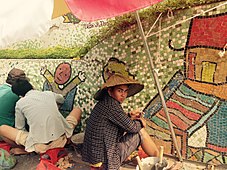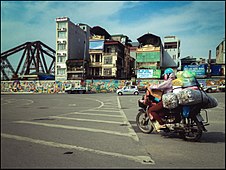Hanoi Ceramic Mosaic Mural
| Hanoi Ceramic Mosaic Mural (Hanoi Ceramic Road) | |
|---|---|
Con đường Gốm sứ | |
 Mural panel with bicyclist | |
 | |
| General information | |
| Status | Completed |
| Location | Hanoi |
| Country | Vietnam |
| Coordinates | 21°02′43″N 105°50′46″E / 21.045356°N 105.845973°E |
| Construction started | 2007[1] |
| Completed | 2010 (with occasional additions) |
| Dimensions | |
| Other dimensions | 4 km (2.5 mi) |

Hanoi Ceramic Mosaic Mural, or Hanoi Ceramic Road (Vietnamese: Con đường Gốm sứ), is a ceramic mosaic mural along the walls of the Red River dike system in the city of Hanoi, northern Vietnam.
With a length of about 6.5 kilometres (4.0 mi), the 'Ceramic Road' is one of the major projects that were developed on the occasion of the Millennial Anniversary of Hanoi.[2]
History
[edit]The Hanoi Ceramic Road originated with the journalist Nguyễn Thu Thủy, who won a prize in the Hanoi architecture contest for her idea of transforming the dike system around Hanoi into a ceramic mosaic.
The work of decoration began in 2007 for the dike wall of about 6.000m in length and 0.95m in height which runs along the road of Âu Cơ, Nghi Tàm, Yên Phụ, Trần Nhật Duật, Trần Quang Khải, Trần Khánh Dư and terminates at the pier of the Long Biên Bridge. She was supported by the Ford Foundation, which funded the first 450 metres (1,480 ft) of the wall; and the planning, training, and infrastructure needed to complete the project.[3] The Ceramic Road was planned to be finished in 2010 to commemorate the Millennial Anniversary of Hanoi in October 2010.[1]
Participating in the work of decoration are not only Vietnamese artists but also foreign embassies and culture centres in Hanoi such as the Goethe-Institut, Alliance française L'espace, British Council, Società Dante Alighieri Dalte Centre, and other cultural centres of Russia and South Korea.[1]
Description
[edit]The mosaic wall mural is made from ceramic tesserae which are product of Bát Tràng, a nearby village famous for its Bát Tràng porcelain.[1]
The content of the mosaic represents the decorative pattern from different periods in the history of Vietnam: Phùng Nguyên culture; Đông Sơn culture; Lý dynasty; Trần dynasty; Lê dynasty and Nguyễn dynasty. Also incorporated on the wall are modern art works, paintings of Hanoi, and children's drawings.[1]
Guinness World Record
[edit]Ms. Nguyen Thu Thuy said the project will strive to make it into the Guinness Book of World Records for the 'World's largest ceramic mosaic' by 2010.[4] On 5 October 2010, Guinness World Records adjudicator, Beatriz Fernandez, undertook an official review of the Hanoi ceramic mosaic to confirm its dimensions and ensure the strict guidelines relating to the record had been followed. Ms Fernandez confirmed that at 3,850 linear meters (6,950m²) of the Hanoi Ceramic Mosaic Mural was the world's largest ceramic mosaic and awarded a Guinness World Records certificate.[5]
Chilean artist Alexandro Mono Gonzalez completed a new segment of the Mural on 18 September 2017.[6] Another segment about Sri Lanka was sponsored by the Sri Lankan Embassy and completed on 22 January 2019.[7] A newly built segment of the concrete dike is expected to have murals on it as well, as the 900-meter-long stretch is currently left plain and attacked by graffiti.[8]
Gallery
[edit]-
Along Hanoi Ceramic Road
-
Mural restoration in 2015
-
Honoring Millennial Anniversary of Hanoi in 2010
-
View across Hanoi Ceramic Road
See also
[edit]- Media relating to Hanoi Ceramic Mosaic Mural in Wikimedia Commons
- Ceramic sculptures
- Murals in Vietnam
- Vietnamese art
References
[edit]- ^ a b c d e Kieu Minh (27 March 2007). "Hanoi to decorate 6,000m of dyke with ceramic painting". Vietnamnet.vn. Archived from the original on 29 September 2010.
- ^ "Bui Xuan Phai's paintings on Hanoi Ceramic Road". Vietnamnet.vn. 7 September 2010. Archived from the original on 12 September 2010. Retrieved 10 September 2010.
- ^ Nguyen, Thuy. "Hanoi Ceramic Mosaic Wall". Hanoi Ceramic Mosaic Wall. Retrieved 20 January 2017.
- ^ VietnamPlus (14 July 2009). "First leg of "Ceramic Road" unveiled". Archived from the original on 18 July 2009. Retrieved 17 September 2010.
- ^ "Largest ceramic mosaic". Guinness. 5 October 2010. Archived from the original on 10 June 2015.
- ^ VTV, BAO DIEN TU (20 September 2017). "Khánh thành đoạn tranh gốm của họa sĩ Chile tại Hà Nội". BAO DIEN TU VTV (in Vietnamese). Retrieved 28 June 2019.
- ^ "Tranh gốm Sri Lanka tuyệt đẹp trên con đường trăm tỷ ở Hà Nội". Báo điện tử Tiền Phong. 25 January 2019. Retrieved 28 June 2019.
- ^ "Sẽ ghép tranh gốm sứ trên con đường Nghi Tàm trăm tỉ bị vẽ bậy". laodong.vn (in Vietnamese). 12 February 2019. Retrieved 28 June 2019.
External links
[edit]- Hanoimural.vn: official website
- Conduonggomsu.vn: official website—(in Vietnamese)
- Murals in Vietnam
- Ceramic sculptures
- Culture of Hanoi
- Mosaics
- Vietnamese pottery
- 2010 sculptures
- Buildings and structures in Hanoi
- Historical sites in Hanoi
- Millennial Anniversary of Hanoi
- 21st century in Hanoi
- 2007 establishments in Vietnam
- Buildings and structures completed in 2010
- 2010 establishments in Vietnam
- Tourist attractions in Hanoi



